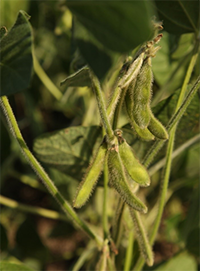 At first glance, it might seem that weed control and disease prevention in soybean fields are two separate considerations. However, they actually go hand in hand. That’s because weeds can act as alternate hosts to some soybean diseases. Meaning, the pathogens will live off certain weeds and transfer to crops.
At first glance, it might seem that weed control and disease prevention in soybean fields are two separate considerations. However, they actually go hand in hand. That’s because weeds can act as alternate hosts to some soybean diseases. Meaning, the pathogens will live off certain weeds and transfer to crops.
So, step one toward disease prevention is good weed control.
White Mold
One disease commonly found on weeds is white mold. Also known as sclerotinia stem rot, the infection is caused by the fungus Sclerotinia sclerotiorum. That pathogen can live on broadleaf weeds like giant ragweed, velvetleaf, lambsquarters and other pigweeds.
Symptoms of white mold tend to show up in July and August, beginning with white-gray lesions on plant nodes. As the infection progresses, white, fluffy mold starts to cover infected areas like stems. Eventually, black sclerotia appears within the mold.
If left untreated, the disease can decrease yield by reducing the soybean seed number, quality and germination.
Pod and Stem Blight
Pod and stem blight is another disease that gets a boost from poor weed control. The fungus Diaporthe phaseolorum causes this infection. The pathogen will live on velvetleaf and pigweeds before moving to soybeans.
Pod and stem blight infections can happen at just about any point in the growing season between May and September. Symptoms include dark specks on stems and pods, with seeds sometimes shriveling or cracking.
The disease can severely damage soybean seed quality, ultimately leading to poor yield.
Disease Prevention
There are several steps you can take to help your customers prevent and control crop disease. The first is to recommend a strong weed control program approach using a residual preemergence like Sonic® herbicide or DuPont™ Trivence® herbicide, followed by a residual postemergence like DuPont™ EverpreX® herbicide, or, for farmers growing Enlist E3® soybeans, Enlist One® and Enlist Duo® herbicides. That will keep broadleaf weeds from acting as disease hosts.
Once you have taken care of the weeds, you also can recommend a foliar fungicide like DuPont™ Aproach Prima fungicide, which has preventive and curative properties. If disease occurs this year, consider applying a fungicide proactively next year.
It’s important to look for signs of infection when scouting your farmers’ fields too. Start by checking lower leaves and stems first, then work your way up.
Finally, there are cultural practices you can take with your growers to prevent infections. These include:
- Picking seed varieties with high disease resistance
- Crop rotation
- Tillage, where possible
Aproach® Prima, Enlist One® herbicide, Enlist Duo® herbicide, EverpreX®, Sonic® and Trivence® are not registered for sale or use in all states. Contact your state pesticide regulatory agency to determine if a product is registered for sale or use in your state. Enlist One and Enlist Duo are the only 2,4-D products authorized for use in Enlist crops. Always read and follow label directions.
The transgenic soybean event in Enlist E3 soybeans is jointly developed and owned by Dow AgroSciences LLC and M.S. Technologies, L.L.C.